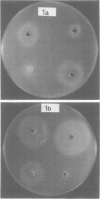Abstract
Assays employing iron-limited solid and liquid, defined and complex media were devised to test the iron requirements of Neisseria meningitidis. A variety of tests yielded no evidence for the secretion of a soluble iron-binding substance (siderophore) by the meningococci. The meningococci were unable to use iron bound to some common hydroxamate- and catechol-type siderophores or even compete with them for iron in the growth medium. A total of 20 strains of meningococci, differing widely in their virulence for mice, were similar in ability to acquire iron from a variety of iron-containing substances; the iron in such compounds as hog gastric mucin, citrate, hemoglobin, and myoglobin was easily acquired, whereas the iron in compounds such as ferrioxamine B, ferrichrome,ferritin, Imferon, cytochrome c, FePO4, and [Fe(OH)3]n was not readily available. No correlation was noted between the ability of particular strains to obtain iron from compounds and virulence in mice. Iron complexed or chelated with a number of metabolic organic acids, polyphosphates, and several synthetic polycarboxylic acids was readily available to all strains, even though some of the compounds used had high effective binding constants for iron and all were in 3- or 10-fold molar excess over the iron present. The addition of some of these iron-complexing substances (e.g., citrate and pyrophosphate) in iron-free form made many biologically important iron compounds that are normally inaccessible to the meningococci readily available.
Full text
PDF
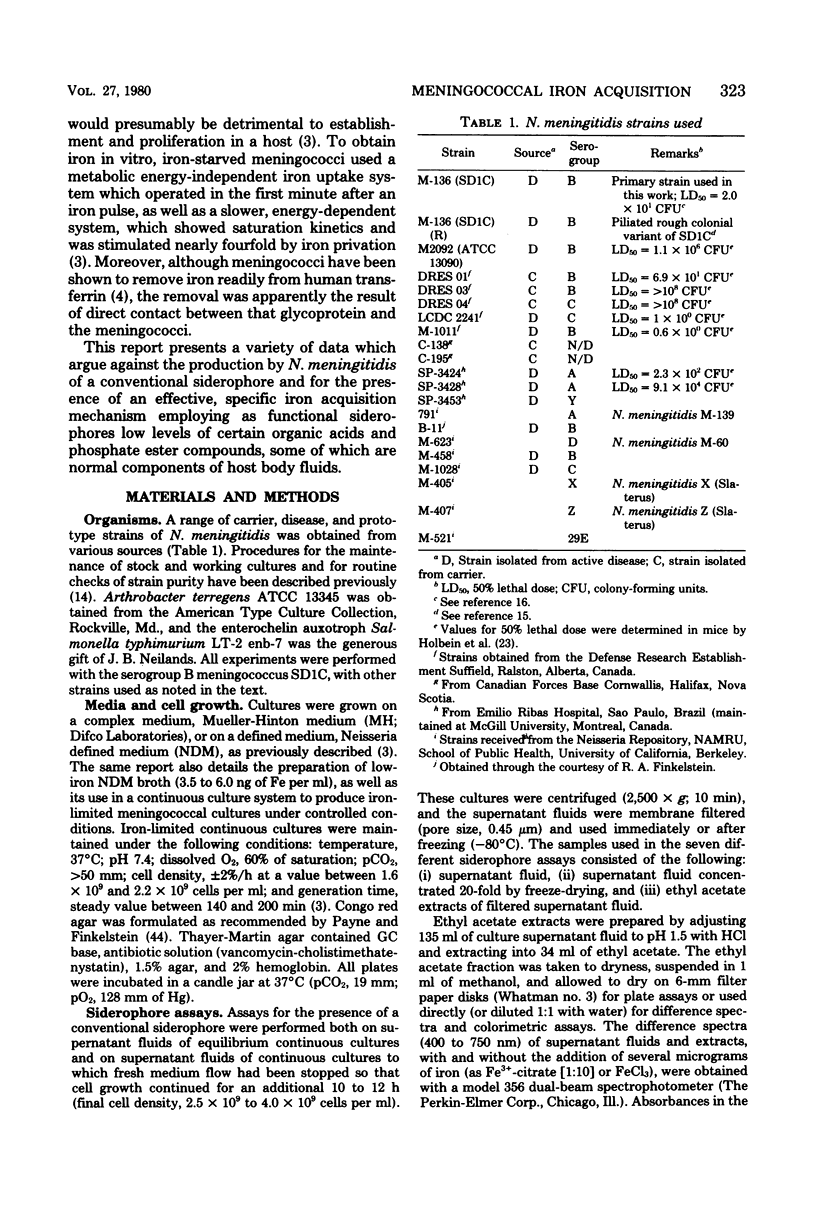




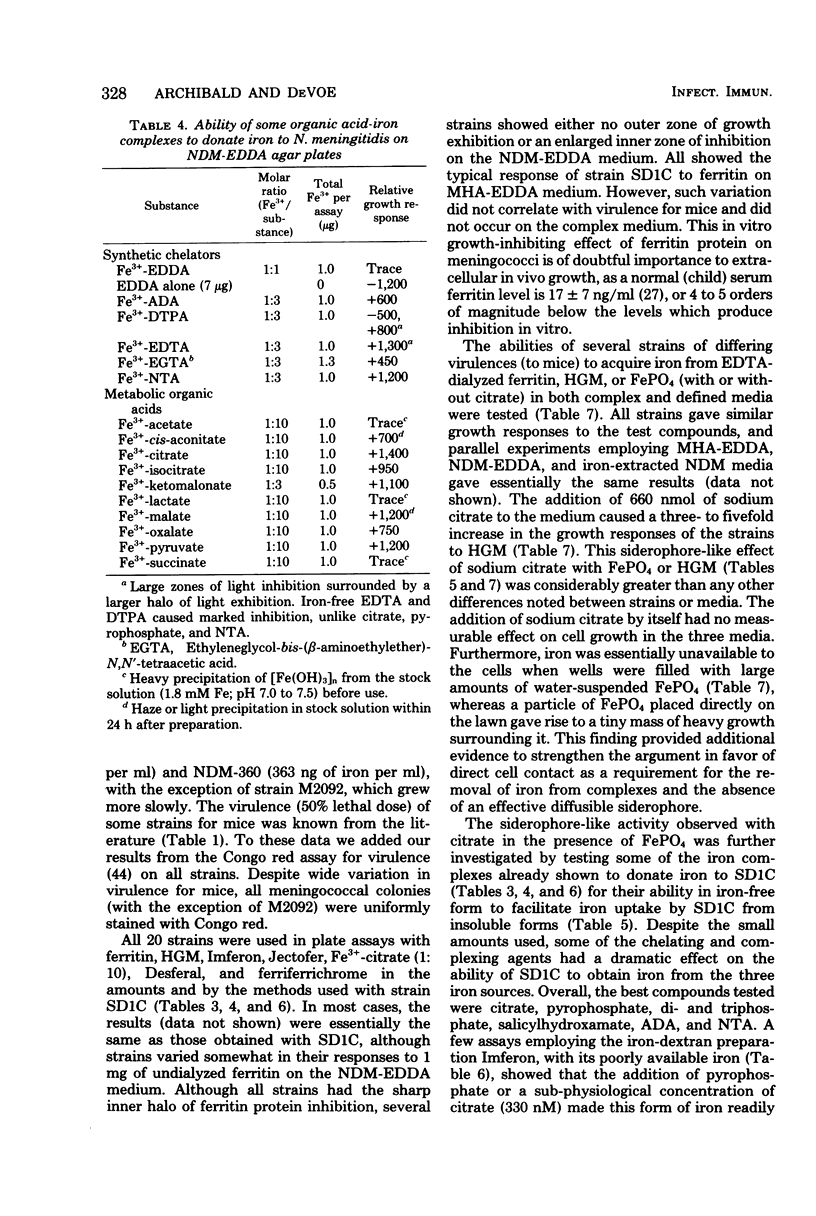



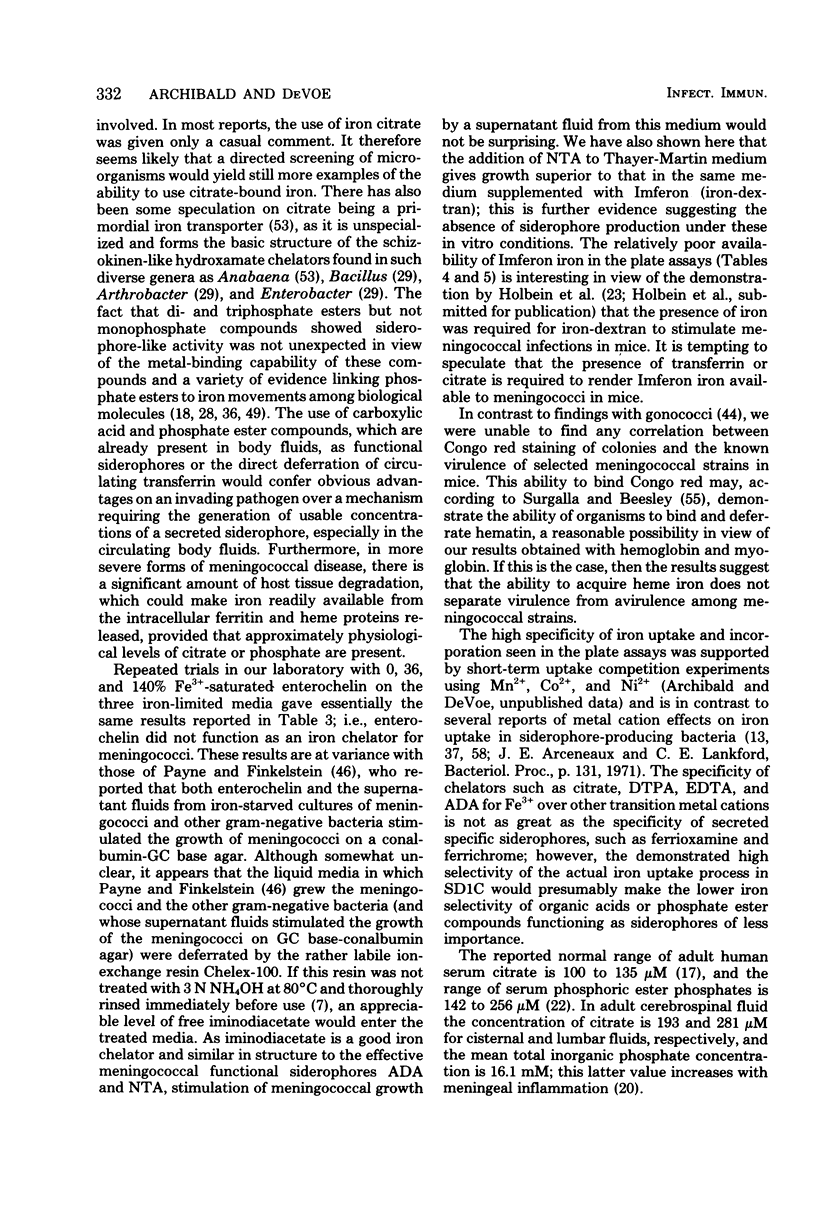
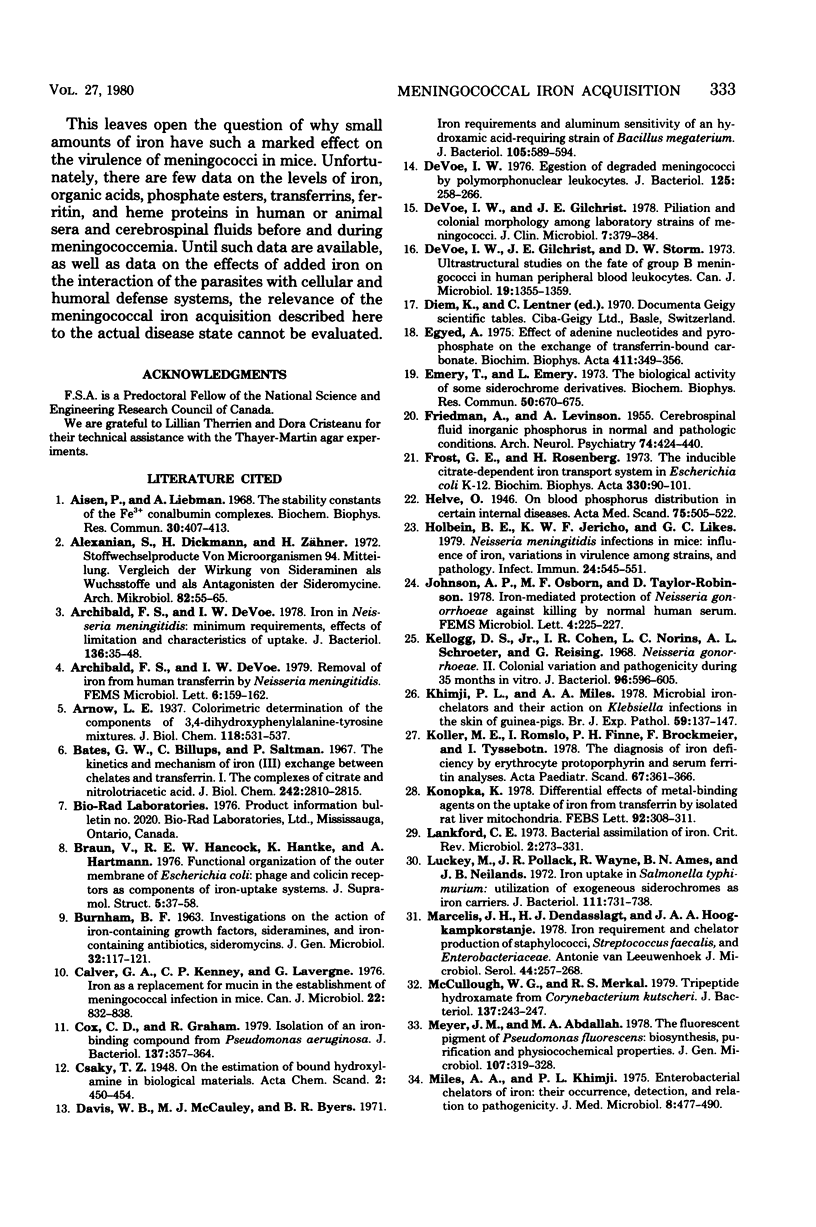

Images in this article
Selected References
These references are in PubMed. This may not be the complete list of references from this article.
- Aisen P., Leibman A. The stability constants of the Fe3+ conalbumin complexes. Biochem Biophys Res Commun. 1968 Feb 26;30(4):407–413. doi: 10.1016/0006-291x(68)90759-6. [DOI] [PubMed] [Google Scholar]
- Alexanian S., Diekmann H., Zähner H. Stoffwechselprodukte von Mikroorganismen. 94. Vergleich der Wirkung von Sideraminen als Wuchsstoffe und als Antagonisten der Sideromycine. Arch Mikrobiol. 1972;82(1):55–65. [PubMed] [Google Scholar]
- Archibald F. S., DeVoe I. W. Iron in Neisseria meningitidis: minimum requirements, effects of limitation, and characteristics of uptake. J Bacteriol. 1978 Oct;136(1):35–48. doi: 10.1128/jb.136.1.35-48.1978. [DOI] [PMC free article] [PubMed] [Google Scholar]
- BURNHAN B. F. INVESTIGATIONS ON THE ACTION OF THE IRON-CONTAINING GROWTH FACTORS, SIDERAMINES; AND IRON-CONTAINING ANTIBIOTICS, SIDEROMYCINS. J Gen Microbiol. 1963 Jul;32:117–121. doi: 10.1099/00221287-32-1-117. [DOI] [PubMed] [Google Scholar]
- Bates G. W., Billups C., Saltman P. The kinetics and mechanism of iron (3) exchange between chelates and transferrin. I. The complexes of citrate and nitrilotriacetic acid. J Biol Chem. 1967 Jun 25;242(12):2810–2815. [PubMed] [Google Scholar]
- Braun V., Hancock R. E., Hantke K., Hartmann A. Functional organization of the outer membrane of escherichia coli: phage and colicin receptors as components of iron uptake systems. J Supramol Struct. 1976;5(1):37–58. doi: 10.1002/jss.400050105. [DOI] [PubMed] [Google Scholar]
- Calver G. A., Kenny C. P., Lavergne G. Iron as a replacement for mucin in the establishment of meningococcal infection in mice. Can J Microbiol. 1976 Jun;22(6):832–838. doi: 10.1139/m76-120. [DOI] [PubMed] [Google Scholar]
- Cox C. D., Graham R. Isolation of an iron-binding compound from Pseudomonas aeruginosa. J Bacteriol. 1979 Jan;137(1):357–364. doi: 10.1128/jb.137.1.357-364.1979. [DOI] [PMC free article] [PubMed] [Google Scholar]
- Davis W. B., McCauley M. J., Byers B. R. Iron requirements and aluminum sensitivity of an hydroxamic acid-requiring strain of Bacillus megaterium. J Bacteriol. 1971 Feb;105(2):589–594. doi: 10.1128/jb.105.2.589-594.1971. [DOI] [PMC free article] [PubMed] [Google Scholar]
- DeVoe I. W. Egestion of degraded meningococci by polymorphonuclear leukocytes. J Bacteriol. 1976 Jan;125(1):258–266. doi: 10.1128/jb.125.1.258-266.1976. [DOI] [PMC free article] [PubMed] [Google Scholar]
- DeVoe I. W., Gilchrist J. E. Piliation and colonial morphology among laboratory strains of meningococci. J Clin Microbiol. 1978 Apr;7(4):379–384. doi: 10.1128/jcm.7.4.379-384.1978. [DOI] [PMC free article] [PubMed] [Google Scholar]
- DeVoe I. W., Gilchrist J. E., Storm D. W. Ultrastructural studies on the fate of group B meningococci in human peripheral blood leukocytes. Can J Microbiol. 1973 Nov;19(11):1355–1359. doi: 10.1139/m73-218. [DOI] [PubMed] [Google Scholar]
- Egyed A. Effect of adenine nucleotides and pyrophosphate on the exchange of transferrin-bound carbonate. Biochim Biophys Acta. 1975 Dec 5;411(2):349–356. doi: 10.1016/0304-4165(75)90314-1. [DOI] [PubMed] [Google Scholar]
- Emery T., Emery L. The biological activity of some siderochrome derivatives. Biochem Biophys Res Commun. 1973 Feb 5;50(3):670–675. doi: 10.1016/0006-291x(73)91296-5. [DOI] [PubMed] [Google Scholar]
- FRIEDMAN A., LEVINSON A. Cerebrospinal fluid inorganic phosphorus in normal and pathologic conditions. AMA Arch Neurol Psychiatry. 1955 Oct;74(4):424–440. doi: 10.1001/archneurpsyc.1955.02330160074010. [DOI] [PubMed] [Google Scholar]
- Frost G. E., Rosenberg H. The inducible citrate-dependent iron transport system in Escherichia coli K12. Biochim Biophys Acta. 1973 Nov 30;330(1):90–101. doi: 10.1016/0005-2736(73)90287-3. [DOI] [PubMed] [Google Scholar]
- Holbein B. E., Jericho K. W., Likes G. C. Neisseria meningitidis infection in mice: influence of iron, variations in virulence among strains, and pathology. Infect Immun. 1979 May;24(2):545–551. doi: 10.1128/iai.24.2.545-551.1979. [DOI] [PMC free article] [PubMed] [Google Scholar]
- Kellogg D. S., Jr, Cohen I. R., Norins L. C., Schroeter A. L., Reising G. Neisseria gonorrhoeae. II. Colonial variation and pathogenicity during 35 months in vitro. J Bacteriol. 1968 Sep;96(3):596–605. doi: 10.1128/jb.96.3.596-605.1968. [DOI] [PMC free article] [PubMed] [Google Scholar]
- Khimji P. L., Miles A. A. Microbial iron-chelators and their action on Klebsiella infections in the skin of guinea-pigs. Br J Exp Pathol. 1978 Apr;59(2):137–147. [PMC free article] [PubMed] [Google Scholar]
- Koller M. E., Romslo I., Finne P. H., Brockmeier F., Tyssebotn I. The diagnosis of iron deficiency by erythrocyte protoporphyrin and serum ferritin analyses. Acta Paediatr Scand. 1978 May;67(3):361–366. doi: 10.1111/j.1651-2227.1978.tb16335.x. [DOI] [PubMed] [Google Scholar]
- Konopka K. Differential effects of metal-binding agents on the uptake of iron from transferrin by isolated rat liver mitochondria. FEBS Lett. 1978 Aug 15;92(2):308–312. doi: 10.1016/0014-5793(78)80776-5. [DOI] [PubMed] [Google Scholar]
- Luckey M., Pollack J. R., Wayne R., Ames B. N., Neilands J. B. Iron uptake in Salmonella typhimurium: utilization of exogenous siderochromes as iron carriers. J Bacteriol. 1972 Sep;111(3):731–738. doi: 10.1128/jb.111.3.731-738.1972. [DOI] [PMC free article] [PubMed] [Google Scholar]
- Marcelis J. H., den Daas-Slagt H. J., Hoogkamp-Korstanje J. A. Iron requirement and chelator production of staphylococci, Streptococcus faecalis and enterobacteriaceae. Antonie Van Leeuwenhoek. 1978;44(3-4):257–267. doi: 10.1007/BF00394304. [DOI] [PubMed] [Google Scholar]
- McCullough W. G., Merkal R. S. Tripeptide hydroxamate from Corynebacterium kutscheri. J Bacteriol. 1979 Jan;137(1):243–247. doi: 10.1128/jb.137.1.243-247.1979. [DOI] [PMC free article] [PubMed] [Google Scholar]
- Miles A. A., Khimji P. L. Enterobacterial chelators of iron: their occurrence, detection, and relation to pathogenicity. J Med Microbiol. 1975 Nov;8(4):477–490. doi: 10.1099/00222615-8-4-477. [DOI] [PubMed] [Google Scholar]
- Miller C. P. EXPERIMENTAL MENINGOCOCCAL INFECTION IN MICE. Science. 1933 Oct 13;78(2024):340–341. doi: 10.1126/science.78.2024.340. [DOI] [PubMed] [Google Scholar]
- Morgan E. H. Iron exchange between transferrin molecules mediated by phosphate compounds and other cell metabolites. Biochim Biophys Acta. 1977 Aug 25;499(1):169–177. doi: 10.1016/0304-4165(77)90239-2. [DOI] [PubMed] [Google Scholar]
- NEILANDS J. B. Some aspects of microbial iron metabolism. Bacteriol Rev. 1957 Jun;21(2):101–111. doi: 10.1128/br.21.2.101-111.1957. [DOI] [PMC free article] [PubMed] [Google Scholar]
- Norrod P., Williams R. P. Effects of iron and culture filtrates on killing of Neisseria gonorrhoeae by normal human serum. Infect Immun. 1978 Sep;21(3):918–924. doi: 10.1128/iai.21.3.918-924.1978. [DOI] [PMC free article] [PubMed] [Google Scholar]
- O'Brien I. G., Cox G. B., Gibson F. Enterochelin hydrolysis and iron metabolism in Escherichia coli. Biochim Biophys Acta. 1971 Jun 22;237(3):537–549. doi: 10.1016/0304-4165(71)90274-1. [DOI] [PubMed] [Google Scholar]
- Payne S. M., Finkelstein R. A. Detection and differentiation of iron-responsive avirulent mutants on Congo red agar. Infect Immun. 1977 Oct;18(1):94–98. doi: 10.1128/iai.18.1.94-98.1977. [DOI] [PMC free article] [PubMed] [Google Scholar]
- Payne S. M., Finkelstein R. A. Imferon agar: improved medium for isolation of pathogenic Neisseria. J Clin Microbiol. 1977 Sep;6(3):293–297. doi: 10.1128/jcm.6.3.293-297.1977. [DOI] [PMC free article] [PubMed] [Google Scholar]
- Payne S. M., Finkelstein R. A. Pathogenesis and immunology of experimental gonococcal infection: role of iron in virulence. Infect Immun. 1975 Dec;12(6):1313–1318. doi: 10.1128/iai.12.6.1313-1318.1975. [DOI] [PMC free article] [PubMed] [Google Scholar]
- Payne S. M., Finkelstein R. A. The critical role of iron in host-bacterial interactions. J Clin Invest. 1978 Jun;61(6):1428–1440. doi: 10.1172/JCI109062. [DOI] [PMC free article] [PubMed] [Google Scholar]
- Pitt C. G., Gupta G., Estes W. E., Rosenkrantz H., Metterville J. J., Crumbliss A. L., Palmer R. A., Nordquest K. W., Hardy K. A., Whitcomb D. R. The selection and evaluation of new chelating agents for the treatment of iron overload. J Pharmacol Exp Ther. 1979 Jan;208(1):12–18. [PubMed] [Google Scholar]
- Pollack S., Vanderhoff G., Lasky F. Iron removal from transferrin. An experimental study. Biochim Biophys Acta. 1977 Apr 27;497(2):481–487. doi: 10.1016/0304-4165(77)90205-7. [DOI] [PubMed] [Google Scholar]
- REICH C. V., HANKS J. H. USE OF ARTHROBACTER TERREGENS FOR BIOASSAY OF MYCOBACTIN. J Bacteriol. 1964 Jun;87:1317–1320. doi: 10.1128/jb.87.6.1317-1320.1964. [DOI] [PMC free article] [PubMed] [Google Scholar]
- Rogers H. J. Iron-Binding Catechols and Virulence in Escherichia coli. Infect Immun. 1973 Mar;7(3):445–456. doi: 10.1128/iai.7.3.445-456.1973. [DOI] [PMC free article] [PubMed] [Google Scholar]
- Surgalla M. J., Beesley E. D. Congo red-agar plating medium for detecting pigmentation in Pasteurella pestis. Appl Microbiol. 1969 Nov;18(5):834–837. doi: 10.1128/am.18.5.834-837.1969. [DOI] [PMC free article] [PubMed] [Google Scholar]
- Tait G. H. The identification and biosynthesis of siderochromes formed by Micrococcus denitrificans. Biochem J. 1975 Jan;146(1):191–204. doi: 10.1042/bj1460191. [DOI] [PMC free article] [PubMed] [Google Scholar]
- VOGEL H. J., BONNER D. M. Acetylornithinase of Escherichia coli: partial purification and some properties. J Biol Chem. 1956 Jan;218(1):97–106. [PubMed] [Google Scholar]
- Wang C. C., Newton A. Iron transport in Escherichia coli: relationship between chromium sensitivity and high iron requirement in mutants of Escherichia coli. J Bacteriol. 1969 Jun;98(3):1135–1141. doi: 10.1128/jb.98.3.1135-1141.1969. [DOI] [PMC free article] [PubMed] [Google Scholar]
- Weinberg E. D. Iron and infection. Microbiol Rev. 1978 Mar;42(1):45–66. doi: 10.1128/mr.42.1.45-66.1978. [DOI] [PMC free article] [PubMed] [Google Scholar]



